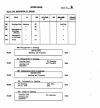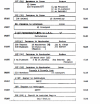Evening history types. 
I’ve always been quite interested in the make up of mail trains during the 1960s/70s and perhaps even into the early 1980s when they still featured vans built to former SR/GWR/LNER and LMS designs.
Would these vans be seen in trains around the whole network back then? For example could you find a BR blue painted Thompson designed 63ft van at Penzance, or perhaps a former Collett K41 design at Inverness?
Other older designs that I can think of that were painted in BR blue are the Stanier 50ft full brake, the western region GWR designed Siphon vans, the Gresley D113 full brake and the SR Bogie B. Were there any other ones?
Of the above, some Siphons and Bogie B’s were definitely still around in the 1980s but when would the other ones have disappeared?
Ok that’s it for the minute. Over to you…

I’ve always been quite interested in the make up of mail trains during the 1960s/70s and perhaps even into the early 1980s when they still featured vans built to former SR/GWR/LNER and LMS designs.
Would these vans be seen in trains around the whole network back then? For example could you find a BR blue painted Thompson designed 63ft van at Penzance, or perhaps a former Collett K41 design at Inverness?
Other older designs that I can think of that were painted in BR blue are the Stanier 50ft full brake, the western region GWR designed Siphon vans, the Gresley D113 full brake and the SR Bogie B. Were there any other ones?
Of the above, some Siphons and Bogie B’s were definitely still around in the 1980s but when would the other ones have disappeared?
Ok that’s it for the minute. Over to you…




